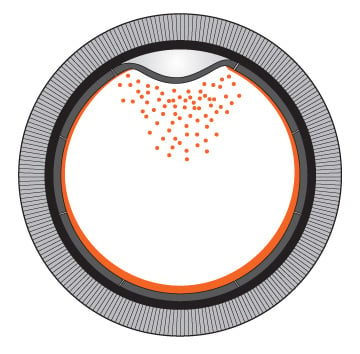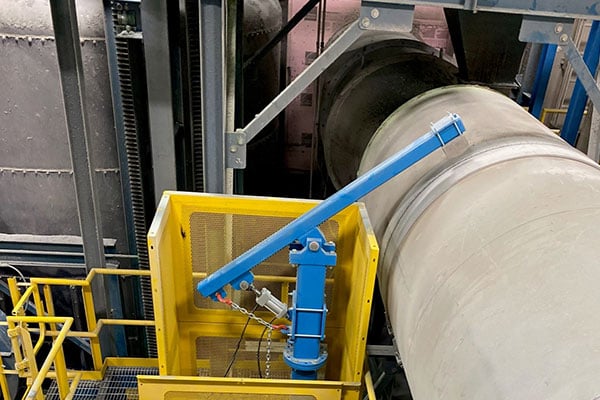Rotary drums are widely used throughout industrial production facilities to accomplish a variety of objectives, including drying, cooling, granulation, coating, and more.
While rotary drum equipment is recognized for its reliability and longevity, challenges can arise, with the most common being buildup, corrosion, and abrasion.
The following covers how operators and maintenance personnel can prevent and keep these challenges under control to promote process efficiency and maximize the service life of their rotary drum.
Rotary Drum Buildup
Buildup, or the caking of material inside the drum, is caused by material sticking to itself, or to the drum’s interior. Buildup may be caused by the chemical composition of the material being processed, the material’s moisture content, or poor material compatibility in the design of the drum.
Fortunately, there are a number of ways to minimize and even prevent buildup.
Controlling Buildup in a Rotary Drum
Depending on the material, and the process, there are several ways to control buildup.
Liners
One option for controlling buildup in a rotary drum is the use of a liner on the drum’s interior. There are many types of liners, from rubber liners, to stainless steel liners, all the way to ceramic tiles, the choice of which is dependent upon the material and the purpose of the liner.
In fertilizer granulators, for example, the liner of choice is often a flexible rubber liner. Flexible rubber liners consist of strips of rubber fixed to the interior, running parallel to the drum. As the drum rotates, gravity causes the rubber to flex downward, sloughing off any material that might have been caked on.
Flexible Rubber Liner
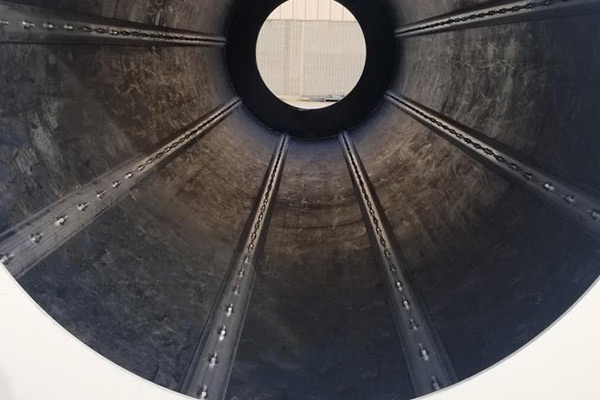
Rubber liner in a granulation drum
Historically, the fertilizer industry used scrapers on the interior of the drum to control buildup. However, the industry has moved away from this because of the potential for the drum to “jump,” or jar, due to the scraper coming in contact with a large, heavy, built-up mass of material. The benefits achieved by moving from scrapers to flexible liners was two-fold for fertilizer manufacturers, because not only did these new liners help control buildup, but they also offered some protection against corrosion.
The addition of a liner is mainly used in the case of granulators, coolers, and agglomerators, when heat is not involved in the process. Heat does not work well with most types of liners – even a stainless steel liner can run into troubles in a heated operation, because the heat causes the liner and base materials to expand at different rates. A stainless steel liner inside a carbon steel shell could have a potential for cracking.
When heat is involved, such as in the case of a rotary dryer or rotary kiln, external means can be taken to help minimize buildup, as opposed to using a liner.
Knocking Systems
Knocking systems, or knockers, are a popular means of externally controlling buildup, both in heated and non-heated drums.
A knocking system uses an externally mounted device to “knock” the drum as it rotates, dislodging any buildup that may be stuck to the drum’s interior, while a wear band or plate protects the drum shell.
FEECO offers two common approaches to knockers: the ball-and-tube design and the pneumatic hammer design.
Ball and Tube Knockers
Ball and tube knocking systems consist of tubes attached to the drum that hold heavy balls, similar to a shotput. As the drum rotates, the ball falls down the tube shaft via gravity, knocking against the drum.
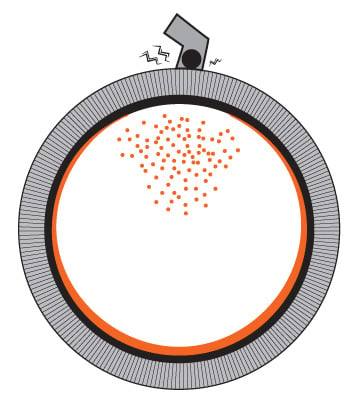
Ball and Tube Knocker
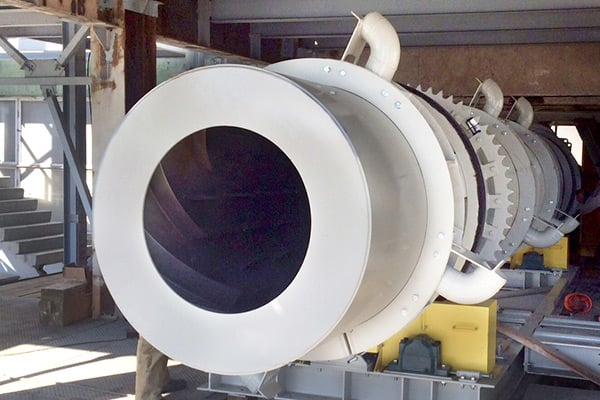
Ball and Tube Knockers can be seen on this coating drum
Pneumatic Hammer Knockers
Pneumatic hammers use a solenoid-activated “hammer” to knock the drum at set time intervals. This more advanced type of knocking system allows for control over strike force, frequency, and interval.
Pneumatic Hammer Knocker
Preventing Buildup
Although there are many ways to keep buildup under control, the best way to control buildup is to prevent it from the start. There are a couple of ways to approach this:
Back Mixing
One way to prevent buildup is to adjust the feedstock using a technique known as back mixing.
This is carried out by adding dry material to the wet, raw material in order to make the feedstock less sticky. However, this is not always an option, as some materials remain sticky for a wide range of moisture levels. When back mixing is not an option, a heated screw could be a more efficient choice.
Flight Design
Another way to prevent buildup is to employ a less aggressive internal flight or lifter.
Because buildup tends to occur in sharp corners, a less aggressive flight can reduce the potential for buildup to occur. While some efficiency is lost, the decline in buildup can be a compensating factor. Additionally, adding a “bald” (flightless) section at the beginning of the drum allows the feedstock to dry a little before it hits the flights, also lessening the chances for buildup to occur.
While buildup is a common challenge faced by those utilizing a rotary drum in their process, there are many methods to combat buildup, as well as prevent it from occurring.
Abrasion and Corrosion
Aside from buildup in a drum, abrasion and corrosion are also common challenges faced by many rotary drum owners. Both types of degradation can result in severe damage if left untreated, making prevention a top priority.
Preventing Abrasion and Corrosion
While abrasion and corrosion act differently, they are typically treated using similar approaches, most often, by carefully selecting the materials of construction, employing protective coatings, and/or using a liner.
Materials of Construction
The proper selection of materials of construction is the single most important way to prevent equipment degradation via abrasion or corrosion (or both) from the start.
An experienced rotary drum manufacturer will work to identify the most suitable material based on the characteristics of the material being processed. This may include the selection of stainless steel, specialty alloys, and corrosion- or abrasion-resistant steels for the drum shell, internals, and supporting equipment such as feed chutes and the like.
While this is typically a concern in the design of new drums, existing drums may require modification in order to combat a corrosive or abrasive material.

Stainless steel coating drum
Protective Coatings
When working with an especially corrosive material, it may be desirable to employ a specialty coating for added protection. Coatings such as epoxy ester, urethane, acrylic, epoxy polymer, and latex offer effective protection from corrosion.
Liners
Various types of liners, as previously covered regarding buildup, can also offer effective protection against corrosion and abrasion in non-heated drums.
The choice of which liner will be most effective in either case – corrosion or abrasion – is dependent on many things, but most importantly, the purpose of the liner, compatibility of materials, and the material temperature.
Conclusion
Whether dealing with buildup, abrasion, or corrosion, there are numerous options for keeping these challenges under control. Addressing these issues, particularly during the initial design process, helps to ensure the resulting drum is fit for a long, reliable service life.
FEECO International custom engineers all rotary drums – coolers, kilns, dryers, granulators, and agglomerators – according to the material and project specifications to reach the most reliable solution possible.
To learn more about our rotary drums, contact us today!



